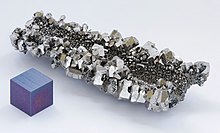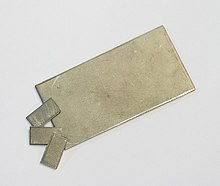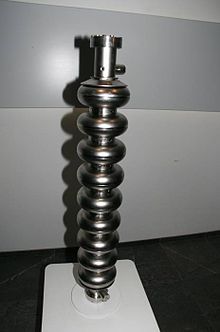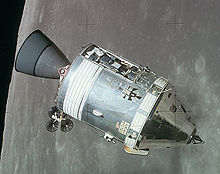niobium
| properties | ||||||||||||||||||||||||||||||||||||||||||||||
|---|---|---|---|---|---|---|---|---|---|---|---|---|---|---|---|---|---|---|---|---|---|---|---|---|---|---|---|---|---|---|---|---|---|---|---|---|---|---|---|---|---|---|---|---|---|---|
| General | ||||||||||||||||||||||||||||||||||||||||||||||
| Name , symbol , atomic number | Niobium, Nb, 41 | |||||||||||||||||||||||||||||||||||||||||||||
| Element category | Transition metals | |||||||||||||||||||||||||||||||||||||||||||||
| Group , period , block | 5 , 5 , d | |||||||||||||||||||||||||||||||||||||||||||||
| Appearance | shiny metallic gray | |||||||||||||||||||||||||||||||||||||||||||||
| CAS number | 7440-03-1 | |||||||||||||||||||||||||||||||||||||||||||||
| EC number | 231-113-5 | |||||||||||||||||||||||||||||||||||||||||||||
| ECHA InfoCard | 100.028.284 | |||||||||||||||||||||||||||||||||||||||||||||
| Mass fraction of the earth's envelope | 19 ppm (34th frequency) | |||||||||||||||||||||||||||||||||||||||||||||
| Atomic | ||||||||||||||||||||||||||||||||||||||||||||||
| Atomic mass | 92.90637 (2) and | |||||||||||||||||||||||||||||||||||||||||||||
| Atomic radius (calculated) | 145 (164) pm | |||||||||||||||||||||||||||||||||||||||||||||
| Covalent radius | 137 pm | |||||||||||||||||||||||||||||||||||||||||||||
| Electron configuration | [ Kr ] 4d 4 5s 1 | |||||||||||||||||||||||||||||||||||||||||||||
| 1. Ionization energy | 6th.75885 (4) eV ≈ 652.13 kJ / mol | |||||||||||||||||||||||||||||||||||||||||||||
| 2. Ionization energy | 14th.32 eV ≈ 1 382 kJ / mol | |||||||||||||||||||||||||||||||||||||||||||||
| 3. Ionization energy | 25th.04 eV ≈ 2 416 kJ / mol | |||||||||||||||||||||||||||||||||||||||||||||
| 4. Ionization energy | 37.611 (22) eV ≈ 3 629 kJ / mol | |||||||||||||||||||||||||||||||||||||||||||||
| 5. Ionization energy | 50.5728 (25) eV ≈ 4 880 kJ / mol | |||||||||||||||||||||||||||||||||||||||||||||
| Physically | ||||||||||||||||||||||||||||||||||||||||||||||
| Physical state | firmly | |||||||||||||||||||||||||||||||||||||||||||||
| Crystal structure | body-centered cubic | |||||||||||||||||||||||||||||||||||||||||||||
| density | 8.57 g / cm 3 (20 ° C ) | |||||||||||||||||||||||||||||||||||||||||||||
| Mohs hardness | 6.0 | |||||||||||||||||||||||||||||||||||||||||||||
| magnetism | paramagnetic ( Χ m = 2.3 10 −4 ) | |||||||||||||||||||||||||||||||||||||||||||||
| Melting point | 2750 K (2477 ° C) | |||||||||||||||||||||||||||||||||||||||||||||
| boiling point | 5017 K (4744 ° C) | |||||||||||||||||||||||||||||||||||||||||||||
| Molar volume | 10.83 · 10 −6 m 3 · mol −1 | |||||||||||||||||||||||||||||||||||||||||||||
| Heat of evaporation | 694 kJ / mol | |||||||||||||||||||||||||||||||||||||||||||||
| Heat of fusion | 26.8 kJ mol −1 | |||||||||||||||||||||||||||||||||||||||||||||
| Speed of sound | 3480 m s −1 at 293.15 K. | |||||||||||||||||||||||||||||||||||||||||||||
| Electric conductivity | 6.58 · 10 6 A · V −1 · m −1 | |||||||||||||||||||||||||||||||||||||||||||||
| Thermal conductivity | 54 W m −1 K −1 | |||||||||||||||||||||||||||||||||||||||||||||
| Chemically | ||||||||||||||||||||||||||||||||||||||||||||||
| Oxidation states | 2, 4, 5 | |||||||||||||||||||||||||||||||||||||||||||||
| Normal potential | −1.1 V (Nb 2+ + 2 e - → Nb) | |||||||||||||||||||||||||||||||||||||||||||||
| Electronegativity | 1.6 ( Pauling scale ) | |||||||||||||||||||||||||||||||||||||||||||||
| Isotopes | ||||||||||||||||||||||||||||||||||||||||||||||
|
||||||||||||||||||||||||||||||||||||||||||||||
| For other isotopes see list of isotopes | ||||||||||||||||||||||||||||||||||||||||||||||
| NMR properties | ||||||||||||||||||||||||||||||||||||||||||||||
|
||||||||||||||||||||||||||||||||||||||||||||||
| safety instructions | ||||||||||||||||||||||||||||||||||||||||||||||
|
||||||||||||||||||||||||||||||||||||||||||||||
|
As far as possible and customary, SI units are used. Unless otherwise noted, the data given apply to standard conditions . |
||||||||||||||||||||||||||||||||||||||||||||||
Niobium [ ˈnioːp ] (after Niobe , the daughter of tantalum ) is a chemical element with the element symbol Nb and the atomic number 41. It is one of the transition metals , in the periodic table it is in the 5th period and the 5th subgroup (group 5) or vanadium group .
In the Anglo-Saxon-speaking area, the name columbium and the abbreviation Cb are still used today by many metallurgists, material suppliers and in private dealings .
The rarely occurring heavy metal is gray in color and easily malleable. Niobium is obtained primarily from the niobium-rich representatives of the pyrochlore upper group , the minerals of the columbite - solid solution series columbite (Mn), columbite (Mn) and loparite . As coltan (a modern, mainly used in politics acronym Col umbit - Tan talit) are called niobium-tantalum ores to the four solid solution series Columbite- (Fe) - Columbite- (Mn) , Tantalit- (Mn) - Count tantalite (Fe) , columbite (Mn) - tantalite (Mn) and columbite (Fe) - tantalite (Fe). Niobium is mainly used in metallurgy to make special steels and improve weldability .
history
Niobium was discovered by Charles Hatchett in 1801 . He found it in a sample of columbite ore from a river bed in Massachusetts that had been shipped to England around 1743. Hatchett named the element columbium (after Columbia , the personification of the United States). Until the middle of the 19th century it was assumed that columbium and tantalum, discovered in 1802, were the same element, since they almost always occur together in minerals.
It was not until 1844 that the Berlin professor Heinrich Rose showed that niobium and tantalic acid are different substances. Not knowing about Hatchett's work and its naming, he named the rediscovered element because of its similarity to tantalum after Niobe , the daughter of tantalum .
Only after 100 years of conflict did the International Union of Pure and Applied Chemistry (IUPAC) establish niobium as the official name of the element in 1950 .
In 1864 Christian Wilhelm Blomstrand succeeded in producing metallic niobium by reducing niobium chloride with hydrogen in the heat. In 1866, Charles Marignac confirmed tantalum as a separate element.
In 1907 Werner von Bolton produced very pure niobium by reducing a heptafluoroniobate with sodium.
Occurrence
Niobium is a rare element with a share of 1.8 · 10 −3 % in the earth's crust . It does not appear dignified . Because of their similar ionic radii , niobium and tantalum are always siblings. The most important niobium minerals are representatives of the columbite-tantalite mixed crystal series with the general formula ( Fe , Mn ) (Nb, Ta ) 2 O 6 , which depending on the dominance of niobium or tantalum as columbite (mixed crystal series columbite (Fe) - columbite - (Mn)) or tantalite (mixed crystal series tantalite (Fe) - tantalite (Mn)), as well as representatives of the pyrochlore group within the pyrochlore upper group. About 85-90% of the niobium industry uses niobium from deposits that do not produce tantalum ores.
The main developed deposits of pyrochlore are in Brazil . The deposits at Araxá are managed by the Companhia Brasileira de Metalurgia e Mineração (CBMM) and, with estimated reserves of 460 million tons, should be sufficient to meet the global demand for niobium for the next 500 years. Another Brazilian deposit with reserves of around 18 million tons of niobium is managed by the Mineração Catalão de Goias . Probably the largest deposits near São Gabriel da Cachoeira have not yet been developed due to their location in the Pico da Neblina National Park and indigenous reserves. The third largest exploited deposit in the world is the Niobec Mine in Canada operated by the Iamgold Group . The three companies mentioned produce ferro-niobium with a nominal Nb 2 O 5 content of 60% and together cover around 85% of world demand for niobium. Other significant, partly under-developed niobium deposits are located in the Lowosero massif in Russia and in the Lueshe deposit in the province of North Kivu , ( Democratic Republic of the Congo ).
Some Nioberze such. B. columbite tantalite ( coltan ) were in 2012 by the US Securities and Exchange Commission SEC as a so-called conflict minerals classified, its use is required to report for companies to the SEC. The reason given for this is the production sites in eastern Congo that are controlled by rebels and are therefore suspected of helping to finance armed conflicts.
Other, mostly rare minerals are:
- Euxenite [(Y, Ca, Ce, U, Th) (Nb, Ta, Ti) 2 O 6 ]
- Olmsteadite (KFe 2 (Nb, Ta) [O | PO 4 ] 2 · H 2 O)
- Samarskite ((Y, Er) 4 [(Nb, Ta) 2 O 7 ] 3 )
Extraction and presentation
Since niobium and tantalum always occur together, niobium and tantalum ores are first digested together and then separated by fractional crystallization or different solubility in organic solvents . The first industrial separation process of this kind was developed by Charles Marignac in 1866.
First, the ores are exposed to a mixture of concentrated sulfuric and hydrofluoric acid at 50–80 ° C. The complex fluorides [NbF 7 ] 2− and [TaF 7 ] 2− , which are easily soluble, are formed.
The dipotassium salts of these fluorides (e.g. potassium heptafluoroniobate ) can be formed by transferring them to an aqueous phase and adding potassium fluoride . Only the tantalum fluoride is sparingly soluble in water and precipitates. The easily soluble niobium fluoride can thus be separated from the tantalum. Nowadays, however, separation by extraction with methyl isobutyl ketone is common. A third possibility of separation is by fractional distillation of the chlorides NbCl 5 and TaCl 5 . These can be produced through the reaction of ores, coke and chlorine at high temperatures.
From the separated niobium fluoride is by reaction with oxygen initially niobium pentoxide produced. This is either first converted to niobium carbide with carbon and then reduced to the metal with further niobium pentoxide at 2000 ° C in a vacuum , or obtained directly by aluminothermically . Most of the niobium for the steel industry is produced in this way, with iron oxide being added to obtain an iron-niobium alloy (60% niobium). If halides are used as the starting material for the reduction, this is done with sodium as the reducing agent.
The annual production in 2006 was almost 60,000 t, 90% of which was mined in Brazil. In 2013, the total amount of niobium produced was 59,400 tons; The main producers were Brazil (53,100 t) and Canada (5,260 t). The USGS gives US import prices for an iron-niobium alloy ( ferroniobium with a 65% niobium share) of USD 37,781 per ton in 2010 and USD 43,415 per ton in 2013.
properties
Niobium is a ductile heavy metal with a gray sheen . The oxidation states −3, −1, 0, +1, +2, +3, +4, +5 are known. As with vanadium , which is above niobium in the periodic table, the +5 level is the most consistent. The chemical behavior of niobium is almost identical to that of tantalum , which is directly below niobium in the periodic table.
As a result of the formation of a passive layer (protective layer), niobium is very resistant to air. Most acids therefore do not attack it at room temperature. Only hydrofluoric acid , especially when mixed with nitric acid , and hot, concentrated sulfuric acid, corrode metallic niobium quickly. Niobium is also unstable in hot alkalis, as they dissolve the passive layer. At temperatures above 200 ° C it begins to oxidize in the presence of oxygen. Welding processing of niobium must take place in a protective gas atmosphere because of its instability in air .
The addition of tungsten and molybdenum to niobium increases its heat resistance and aluminum increases its strength.
Niobium becomes superconducting below 9.26 K and is therefore the superconducting element with the highest transition temperature .
Niobium easily absorbs gases, so one gram of niobium can absorb 100 cm³ of hydrogen at room temperature , which was previously used in vacuum tube technology .
use
Niobium is used as an alloy additive for stainless steels, special stainless steels (e.g. pipes for hydrochloric acid production) and non-ferrous alloys, as niobium-alloyed materials are characterized by increased mechanical strength. Even in concentrations of 0.01 to 0.1 percent by mass, niobium in combination with thermomechanical rolling can significantly increase the strength and toughness of steel. First attempts to use niobium as an alloying element (replacement of tungsten ) took place in the USA in 1925. Steels refined in this way are often used in pipeline construction. As a strong carbide former, niobium is also added to welding consumables to bind carbon.
Other uses are:
- Application in nuclear technology because of the low capture cross-section for thermal neutrons .
- Manufacture of niobium-stabilized welding electrodes as welding filler for stainless steels , special stainless steels and nickel-based alloys .
- Because of its bluish color, it is used for piercing jewelry and jewelry making.
- In aluminum alloys, it is used to manufacture lightweight but stiff components and vehicles, such as the rims of bicycles.
- In the case of coins with niobium (bimetal coins), the color of the niobium core can vary greatly due to physical processes (e.g. 25 euro coins from Austria).
- Significant quantities are used as ferroniobes and nickel niobes in the metallurgical industry for the production of superalloys (nickel, cobalt and iron-based alloys). Static parts for stationary and flying gas turbines, rocket parts and heat-resistant components for furnace construction are manufactured from this.
- Niobium is used as an anode material in niobium electrolytic capacitors . An oxide of niobium, niobium (V) oxide, has a high dielectric strength. It is applied to the surface of the niobium anode in a so-called forming process and serves as a dielectric in this capacitor. Niobium electrolytic capacitors compete with the more popular tantalum electrolytic capacitors .
- Are the glass bulbs of halogen bulbs outside with z. B. niobium, part of the thermal radiation of the tungsten filament is reflected back to the inside. As a result, a higher operating temperature and thus greater luminous efficiency can be achieved with lower energy consumption.
- As a catalyst (e.g. in hydrochloric acid production, in biodiesel synthesis and in the production of alcohols from butadiene).
- As potassium niobate (chemical compound of potassium, niobium and oxygen), which is used as a single crystal in laser technology and for non-linear optical systems
- Use as electrode material for high pressure sodium vapor lamps
- Superconductivity : At temperatures below 9.5 K, pure niobium is a type II superconductor . Niobium alloys (with N, O, Sn, AlGe, Ge) belong to the type II substances in addition to the pure elements niobium, vanadium and technetium -Superconductors are: The transition temperatures of these alloys are between 18.05 K ( niobium tin Nb 3 Sn) and 23.2 K ( niobium germanium Nb 3 Ge). Superconducting cavity resonators made of niobium are used in particle accelerators (including XFEL and FLASH at DESY in Hamburg). - To generate high magnetic fields of up to about 20 Tesla, superconducting magnet coils with wires made of niobium-tin or niobium-titanium are used, e.g. B. in the ITER fusion test reactor 600 t niobium-tin and 250 t niobium-titanium. The LHC's superconducting magnet coils are also made of niobium alloys.
- Due to its biocompatibility, niobium is used for the surface coating of implants.
- To counteract intergranular corrosion , niobium is used as an alloying element in Cr steels. For this purpose, it should be present in at least twelve times the concentration of carbon. Niobium forms carbides faster than chromium. Therefore, there is no formation of chromium-rich carbides, which would mean that chromium-depleted areas arise elsewhere in the structure.
safety instructions
Niobium is considered non-toxic, but metallic niobium dust irritates eyes and skin. Niobium dust is highly flammable.
A physiological mode of action of niobium is unknown.
literature
- Hans Breuer: dtv-Atlas Chemie. 9th edition. Volume 1, dtv-Verlag, 2000, ISBN 3-423-03217-0 .
- M. Binnewies: General and Inorganic Chemistry. 1st edition. Spektrum Verlag, 2004, ISBN 3-8274-0208-5 .
- Sergeij Venetzkij: Stories about metals . 3rd, through Edition. German publishing house for basic industry, 1988, ISBN 3-342-00324-3 .
- Rudolf Riedelbauch: Investigations into metallic vanadium, niobium and tantalum. Dissertation . Munich 1907.
- Charles Kittel: Introduction to Solid State Physics. 9th edition. Oldenbourg Verlag, 1991, ISBN 3-486-22018-7 .
- Harry H. Binder: Lexicon of the chemical elements - the periodic table in facts, figures and data. Hirzel, Stuttgart 1999, ISBN 3-7776-0736-3 .
Web links
Individual evidence
- ↑ a b Harry H. Binder: Lexicon of the chemical elements. S. Hirzel Verlag 1999, ISBN 3-7776-0736-3 .
- ↑ The values of the atomic and physical properties (info box) are taken from www.webelements.com (Niob) .
- ↑ CIAAW, Standard Atomic Weights Revised 2013 .
- ↑ a b c d e Entry on niobium in Kramida, A., Ralchenko, Yu., Reader, J. and NIST ASD Team (2019): NIST Atomic Spectra Database (ver. 5.7.1) . Ed .: NIST , Gaithersburg, MD. doi : 10.18434 / T4W30F ( https://physics.nist.gov/asd ). Retrieved June 11, 2020.
- ↑ a b c d e Entry on niobium at WebElements, https://www.webelements.com , accessed on June 11, 2020.
- ^ NN Greenwood, A. Earnshaw: Chemistry of the elements. 1st edition. 1988, ISBN 3-527-26169-9 , p. 1260.
- ↑ Robert C. Weast (Ed.): CRC Handbook of Chemistry and Physics . CRC (Chemical Rubber Publishing Company), Boca Raton 1990, ISBN 0-8493-0470-9 , pp. E-129 to E-145. Values there are based on g / mol and given in cgs units. The value specified here is the SI value calculated from it, without a unit of measure.
- ↑ a b Yiming Zhang, Julian RG Evans, Shoufeng Yang: Corrected Values for Boiling Points and Enthalpies of Vaporization of Elements in Handbooks. In: Journal of Chemical & Engineering Data . 56, 2011, pp. 328-337, doi: 10.1021 / je1011086 .
- ↑ a b Entry on niobium (powder) in the GESTIS substance database of the IFA , accessed on April 30, 2017(JavaScript required) .
- ↑ Mineral Atlas: Loparit- (Ce) .
- ^ AF Holleman , E. Wiberg , N. Wiberg : Textbook of Inorganic Chemistry . 102nd edition. Walter de Gruyter, Berlin 2007, ISBN 978-3-11-017770-1 , p. 1553.
- ^ Dtv-Atlas Chemie. Volume 1, dtv-Verlag, 2000.
- ^ Niobium deposits .
- ^ SEC: Conflict Minerals - Final Rule. 2012, p. 34f, (PDF, 1.96 MB, engl.)
- ↑ SEC Adopts Rule for Disclosing Use of Conflict Minerals. Accessed September 3, 2012.
- ↑ Joachim Eckert: Niobium and Niobium Compounds. In: Ullmann's Encyclopedia of Industrial Chemistry. Wiley-VCH, 2000, doi : 10.1002 / 14356007.a17_251 .
- ↑ Niobium at usgs.gov (PDF file; 61 kB).
- ↑ MINERAL COMMODITY SUMMARIES 2015. (PDF 2.3 MB, pp. 110–111) USGS , accessed on October 7, 2015 (English).
- ^ Neil Ashcroft , David Mermin : Solid State Physics . Saunders College, 1976, ISBN 0-03-083993-9 .
- ↑ CA Deshmane, JB Jasinski, P. Ratnasamy, MA Carreon: Synthesis and catalytic properties of mesoporous, bifunctional, gallium-niobium mixed oxides. In: Chem Commun (Camb). 46 (34), Sep 14, 2010, pp. 6347-6349. PMID 20714564 .
- ↑ Thomas J. Haley, N. Komesu, K. Raymond: Pharmacology and toxicology of niobium chloride . In: Toxicology and Applied Pharmacology . tape 4 , no. 3 , 1962, pp. 385-392 , doi : 10.1016 / 0041-008X (62) 90048-0 , PMID 13903824 .
- ^ Henry A. Schroeder, Marian Mitchener, Alexis P. Nason: Zirconium, Niobium, Antimony, Vanadium and Lead in Rats: Life term studies . In: Journal of Nutrition . tape 100 , no. 1 , 1970, p. 59-68 , PMID 5412131 .






